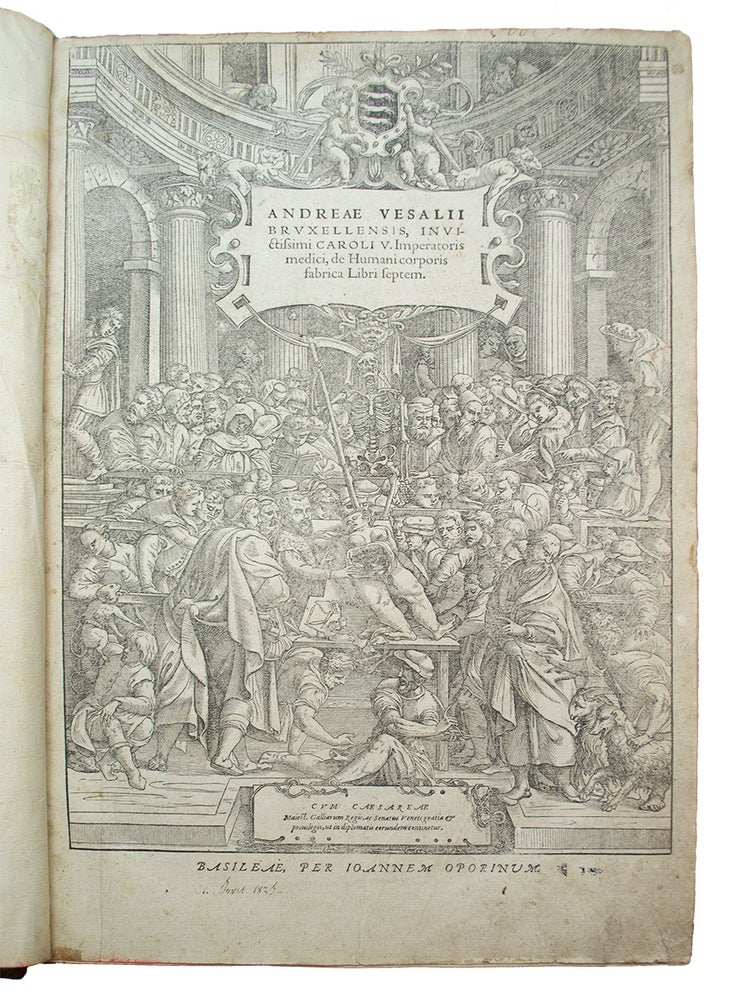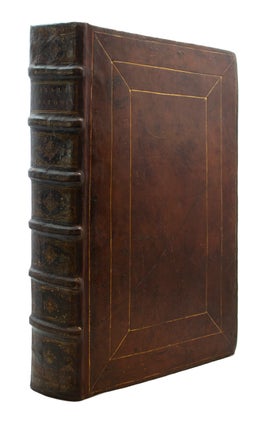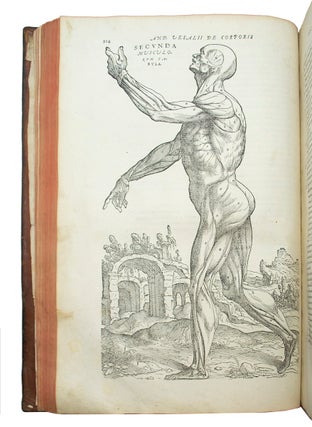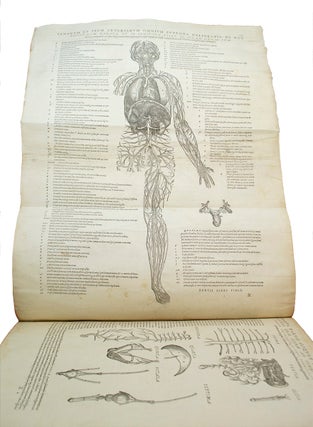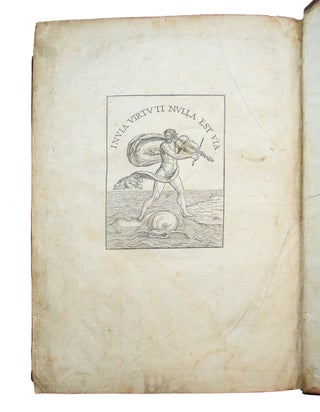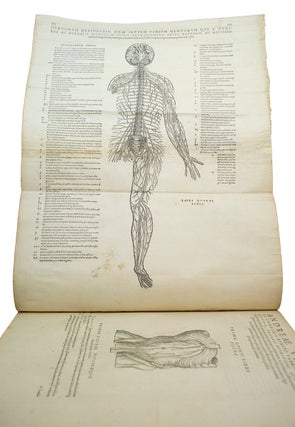The Second and Best Folio Edition of Vesalius
De humani corporis fabrica libri septem.
Basel: Per Ioannem Oporinum, 1555.
Basel: Per Ioannem Oporinum, [1555].
Second and best folio edition (first published in 1543) of the most important anatomical treatise of the sixteenth century. With author's final additions and corrections as well as a renewed woodcut title-page and and initials. Large folio (16 x 10 7/8 inches; 407 x 275 mm). [12], 504, [1, folding table paginated “505”], [1, unpaginated leaf of figures to be superimposed], 507-824, [48] pp. Collation: a-z6 A-V6 X2 (including fold-out sheet) Y-Z6 aa6 bb8 (bb 6-7 is fold-out sheet) cc- zz6 Aa8 Bb-Ee6. Complete with woodcut title, woodcut portrait of the author on a6 verso, numerous woodcut illustrations (including nineteen full-page anatomical illustrations), two folding tables with woodcut diagrams, woodcut printer’s device on verso of final leaf, and seven-to twelve-line historiated woodcut initials.
Full 17th century paneled calf, boards paneled in gilt. Rebacked with early spine laid- down. Spine stamped in gilt. Red Morocco spine label, lettered in gilt. With some expert restoration to folding plates. A small professional repair to page 203. Some minor marginal staining to pages 509-566 and 794 through the end. A handsome copy with crisp clean pages. Overall a very good copy.
“This edition contains Vesalius’s final revisions of the text, along with significant typographical improvements and refinements. Oporinus set the second folio edition in larger type (forty-nine instead of fifty-seven lines per page), which required recutting of all the small initials letters so that they could fit seven lines of the new type. Oporinus also used heavier and finer paper for the second edition, and improved the presswork so that the second edition is a superior example of bookmaking” (Norman Library).
Aside from the renewed engraved title-page and initials, this second edition (1555) used the same plates as the first edition. The woodblocks survived in Germany until the Second World War during which they were destroyed while in the Munich Library. Before they were destroyed in the war, the Bremer press published their 1935 Andreae Vesalii Bruxellensis Icones Anatomicae edition useing the original blocks from 1543 and 1555, and interspersed passages of text, the "key" to the illustrations from the 1555 (present) edition.
“The young Vesalius, with an iconoclastic zeal characteristic of the sixteenth century, and a forcible style all his own, endeavoured to do all that Galen had done and to do it better. The result was ‘The Structure of the Human Body’, published when he was twenty-nine; a complete anatomical and physiological study of every part of the human body, based on first-hand examination and his five years’ experience as public prosector in the medical school at Padua. The five books deal with the bones and muscles, blood vessels, nerves, abdominal viscera, thoracic organs and the brain. Galen was not merely improved upon: he was superseded; and the history of anatomy is divided into two periods, pre-Vesalian and post-Vesalian. The Fabrica, a handsomely printed folio, is remarkable for its series of magnificent plates, which set new technical standards of anatomical illustrations, and indeed of book illustration in general. They have generally been ascribed to an artist of Titian’s school, long (but no longer) thought to be Jan Stephen van Calcar (1499-c. 1550). Vesalius’s was the most splendid and the most comprehensive of a large number of anatomical treatises of the sixteenth century. The second edition (1555) used the same plates (the woodblocks indeed survived in Germany until the Second World War) but contains minor variations in the text. No other work of the sixteenth century equals it” (Printing and the Mind of Man ).
Adams V605.Choulant-Frank, pp. 181-182. Cushing, Vesalius, VI.A.-3. Garrison and Morton 377. NLM/Durling 4579. Norman Library 2139. Osler 568. Waller 9901. Wellcome 6562. Printing and the Mind of Man 71 (describing the 1543 first folio edition).
HBS 68434.
$105,000.
Price: $105,000.00
Item #68434

